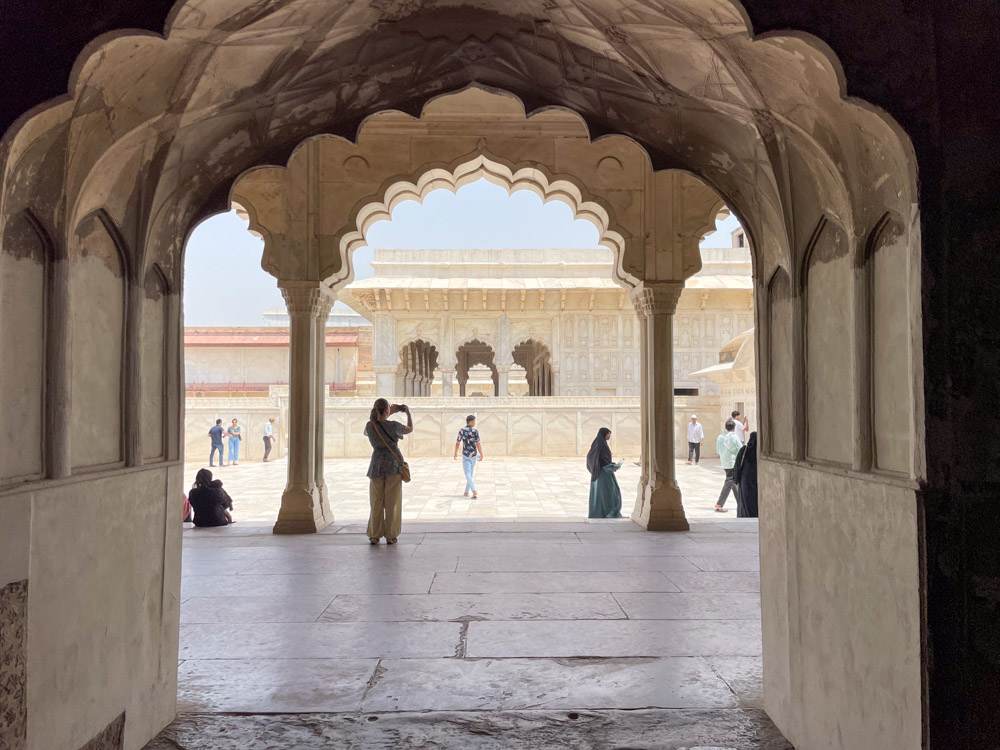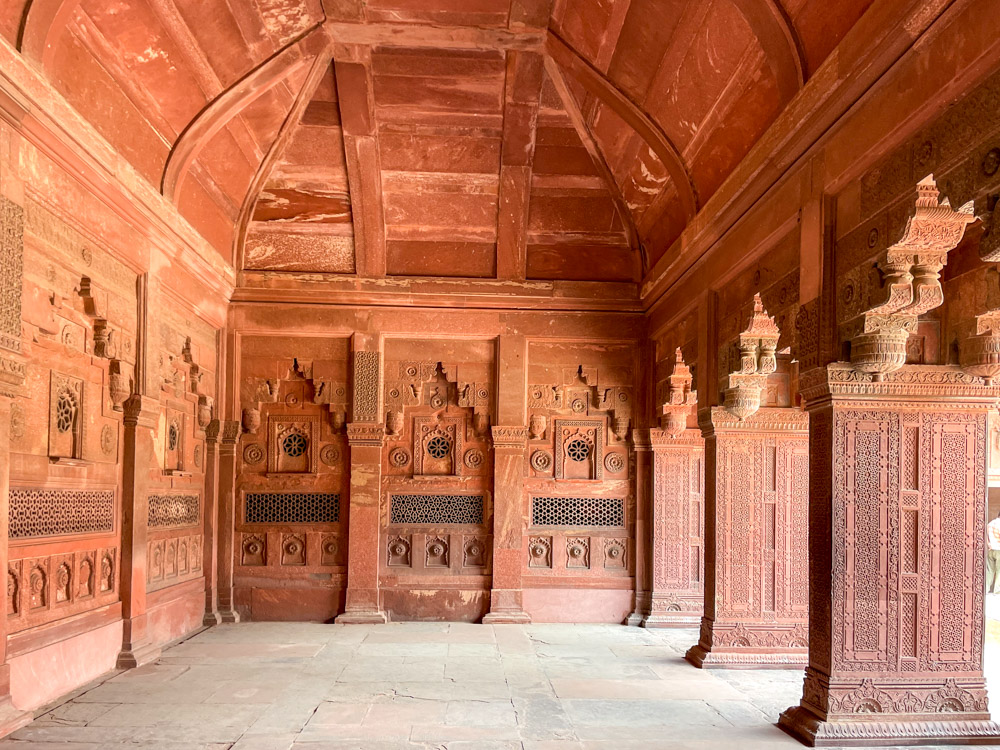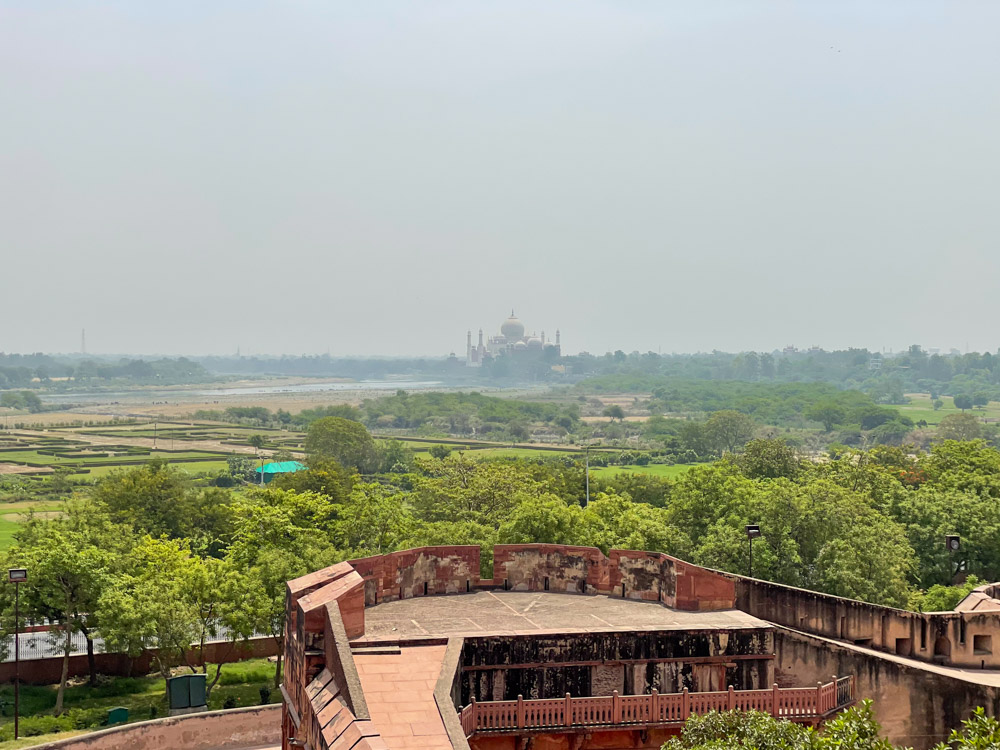The Agra Fort, also known as Lal Qila, was the primary residence of the emperors of the Mughal dynasty until 1638, when the capital shifted from Agra to Delhi. Today, it is an important fortification recognised as a UNESCO World Heritage Site. Through its extraordinary architecture and glorious past of ancient imperial dynasties, it tells an essential part of Indian history, which you can discover by reading this article.
Table of Contents
The Red Fort of Agra’s history
The Agra Fort is a majestic example of fortified architecture and stands out in all its magnificence above the city. The common fort’s name, Red Fort in English, comes directly from the material used for its construction, red sandstone. This stone gives the building its distinctive colour, unique in Indian fortifications.
PLAN YOUR TRIP TO INDIA
When in India, stay connected at the best rates by purchasing an Airalo eSIM online before your trip. This eliminates the hassle of purchasing a physical SIM at the airport.
About travel insurance, Heymondo is the way to go. They offer comprehensive coverage against unexpected events like medical emergencies, trip cancellations, lost luggage, and more. Heymondo provides excellent value for money and will give you peace of mind on your travels!
Although the Mughal rulers, the Muslim imperial dynasty, built the present structure, its roots go back to the 11th century. Initially, the fortress was known as Badalgarh, under the rule of Raja Badal Singh, a Hindu Rajput. The fundamental transformation of the fortress began under Sikandar Lodi, the first Delhi sultan to settle in Agra. During his reign, the fort assumed a position of strategic importance, and Agra became the second capital of India.
Over the centuries, the Agra Fort passed through the hands of various Mughal emperors. Consequently, it went under constant renovations to reflect the tastes and needs of each ruler. In the 18th century, the Maratha Empire invaded and conquered the fort, initiating a period of instability. Control over the fort passed several times between the Maratha and their political opponents.
Finally, the fort played a prominent role during the Indian Rebellion of 1857. During the Great Indian Mutiny, called the First Indian War of Independence by the Indians, Indian soldiers occupied the fortress. However, the revolt in protest against the colonial power exercised by the British East India Company was quelled. Following the rebels’ defeat, the British authorities exercised direct rule over most of India for the next 90 years.

What to see inside the Agra Fort
Today, the Agra Fort is a UNESCO World Heritage Site and one of India’s top tourist attractions. Every stone of this fort tells stories of power, politics and passion, making it an extraordinary experience for visitors wishing to immerse themselves in India’s history.
The Red Fort is semicircular and covers 380,000 square metres. Surrounded by mighty walls 23 metres high, interspersed with circular ramparts, it has four imposing gates opening on each side of the fort. Only the Khizri gate faces the river. Inside the walls are additional structures, such as residential buildings and a curious stone basin, which tell the story of the Mughal era.
The architecture of the Agra Fort
Built mainly of red sandstone, hence the name Red Fort, the Agra Fort has a semicircular shape. Its base extends along the bank of the Yamuna River. The mighty double walls of this fortress, with a circumference of two kilometres, are adorned with beautiful curves and tall towers.
This ancient fortress has four imposing entrance gates, including the Delhi Gate and the Lahore Gate. In addition, there is an inner gate known as the Elephant Gate. Inside the Agra Fort is a series of halls and palaces, including the Macchi Bhavan, the Khas Mahal and the Shah Jahani Mahal. These buildings testify to the luxury and sophistication of Mughal architecture.
To the right of the fortress is the Diwan-I-Am, a place of royal audience. A little further on are other sumptuous buildings, including the Nagina Masjid and the Mina Masjid. The fort also houses places of worship and an area reserved for women as a meeting place. However, many surrounding buildings that once enriched the fort’s landscape have been lost.
Below, you can read about the main attractions inside the Red Fort in Agra. However, if you don’t have a guide for your tour in India, I recommend hiring a licensed guide at the entrance. Them can guide you around the complex, as there are many things to see.

Ghaznin Gate
The Ghaznin Gate has a very curious history because it originally belonged to Mahmud Ghaznavi’s tomb in Ghazni and was brought to Agra by the British in 1842. The Governor General, Lord Ellenborough, claimed that it was the sandal gate of the Somnath temple that Mahmud had taken away to Ghazni in 1025. The claim was, however, false, made only to gain the favour of the Indian people.
The door, made of local deodar wood from Ghazni and not sandalwood, bears a decoration similar to ancient Gujarat woodwork. At the top is an inscription in Arabic mentioning Mahmud and his titles. The door has imposing dimensions. It is made of hexagonal and octagonal geometric panels, fixed one above the other in the frame without rivets.
Jahangir’s Chain of Justice
Jahangir’s Chain of Justice was the method instituted by the Mughal king Jahangir by which the oppressed, regardless of caste, census or religion, could report bad behaviour by those who had to administer justice. They just had to warn the ruler through a chain with bells, fixed between the battlements of the Agra Fort and to a stone post on the river bank.
Made of pure gold, Jahangir’s Chain of Justice was about 24 metres long and equipped with 60 bells weighing about a quintal. The existence of Jahangir’s Chain of Justice is not a legend because it was seen in person by foreign travellers such as William Hawkins and depicted in a painting.
Jahangir’s Hauz bathtube
The Jahangir’s Hauz is a considerable stone tub once used for bathing. A decoration on the outside with an inscription in Persian mentions it as Hauz-e-Jahangir. Discovered near the courtyard of Akbar’s palace, the basin was later placed in front of the Diwan-e-Am. Moved to a public garden, it suffered some damage before finding its final place in the Agra Fort.

Shahjahani Mahal Palace
The Shahjahani Mahal palace stands between the white marble Khas Mahal building and the red sandstone Jahangiri Mahal, two residential complexes from different eras. This building is famous because it was the first attempt by the Mughal emperor Shahjahan to modify an existing building according to his taste.
The brick and red sandstone structure was, in fact, wholly repainted with thick white plaster to make it look like marble and decorated with colourful floral designs. The Shahjahani Mahal was Emperor Shahjahan’s first residential palace within the Agra Fort. It includes a great hall, side rooms and an octagonal tower on the riverside.
Shish Mahal Summer Palace
The Mughal Emperor Shahjahan built the Shish Mahal as part of the summer palace. Its distinctive feature is the glass mosaic on the walls and ceiling. Made from glass imported from Syria, it made the semi-dark interiors of the palace incredibly sparkling.
These wonders are just some things to see inside the Agra Fort. The complex is quite vast, and I recommend you visit it with a guide to appreciate it at its best and orient yourself inside.

Practical information for visiting the Agra Fort
The Agra Fort, located just 2.5 km from the famous Taj Mahal, is a frequently visited destination along with the mausoleum. The fort is open seven days a week, and you can buy tickets directly on-site, as I did on my trip to India. At the time of writing, buying tickets online is impossible. However, the Agra Fort is so big that there should be no problem entering even during the busiest periods.
Regarding the climate, I advise you to avoid the hottest months when planning your trip. The best months to visit the Agra Fort and the Taj Mahal are from November to February. During this period, the climate is dry and slightly less hot. However, take a good water supply with you and don’t hesitate to buy fresh water bottles from roadside vendors to avoid the risk of dehydration.
You can reach Agra with a three-hour drive from Delhi or a five-hour drive from Jaipur in Rajasthan. Although Agra is in Uttar Pradesh and not in Rajasthan, because of its proximity, it is almost always included in tours of northern India, especially for the presence of the Taj Mahal, a must-see attraction. Agra is also well connected by public transport to major Indian cities, with regular trains from Delhi, Jaipur, Gwalior and Jhansi. Once in the city, you can travel by taxi or tuk-tuk to the Red Fort of Agra.
Red Fort of Agra
Agra Fort, Rakabganj
Agra, Uttar Pradesh 282003, India
The Red Fort of Agra is a journey through time into the grandeur of the Mughal Empire and a must-see destination on a trip to northern India for its impressive architecture. You can still feel the echoes of past kingdoms and decisions that shaped history through its walls and structures. Feel free to share your thoughts about the Agra Fort in the comments and if you will combine it with a visit to the nearby Taj Mahal.
